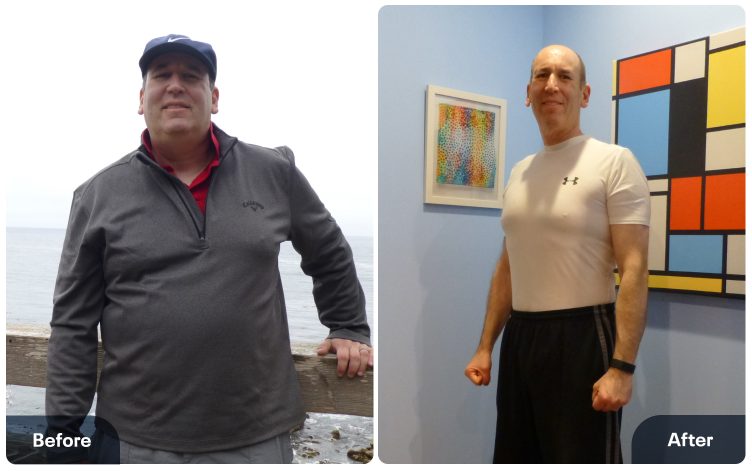
Michael Tracked His Meals for 1,000 Straight Days and Lost 65 Pounds
Lifestyle changes are often spurred by events that reframe reality. For Michael Pasternack, that event was an eye-opening doctor visit in early 2019. His doctor expressed concern with his health, noting he was prediabetic and had high cholesterol, telling him he’d soon need to take prescription drugs for both conditions. The Long Island-based attorney was already taking daily medicine for GERD, and his feet hurt from supporting his 239 pounds.
“One doctor talked me into seeing a dietitian, though I was skeptical,” says Pasternack, who admits he wasn’t ready to follow the suggested diet or commit to regular exercise. “But one thing stuck with me. She said a huge key to weight-loss success was tracking your food intake,” offering the catchy saying, “you bite it, you write it.” So, Pasternack went home, downloaded the MyFitnessPal app and started tracking his food to get a sense of what he was eating. That small step turned into a major change, as he continued inputting his calories each day, recently hitting 1,000 straight days of tracking.
Before that fateful doctor’s appointment, Pasternack hated exercise, made poor meal choices, and excessively snacked on sugary treats like cakes, cookies and candy. Once he set his sights on getting healthy, he started slowly by tracking his food and walking a couple of days per week. Soon, he began to eliminate unnecessary snacks and modified his meals to be more nutritious. Bacon, egg and cheese breakfast sandwiches turned into Greek yogurt with fruit or sliced turkey on wheat toast. He began to walk more and for longer durations. He dropped 20 pounds in 10 weeks. “It wasn’t that difficult for me, so I kept going, sticking with my daily calories and continuing to exercise.”
Today, 53-year-old Pasternack still uses the MyFitnessPal app to track his food. “Once you get the hang of it, you can enter a meal very quickly,” he says. He also checks his macros (though he doesn’t stress if he misses the mark), employs the barcode scanner to easily enter packaged foods, and saves his favorite recipes.
“I keep to the daily calories allotted by the MyFitnessPal app, sometimes having to work a bit to meet daily protein and fiber goals,” he says. Breakfast is usually eggs, yogurt and fruit, or high-fiber cereal with almond milk. He eats a lot of salads and snacks on vegetables and fruit instead of his old staples. “I have never felt like I was starving myself,” he says. “Even today I will still have some of my old favorites, just not multiple portions and not daily.”
Pasternack performs cardio exercises 6–7 days per week for 45–60 minutes, usually walking outside or hiking, or hopping on the treadmill or elliptical. He mixes in strength training every other day with dumbbells or resistance bands, and he does a daily set of bodyweight exercises, like pushups or crunches.
“I feel like a slug if I skip a day of exercise, but I know it’s good to take an occasional day off,” he says. “The exercise is also good for reducing stress and clearing my mind. And I don’t mind that I needed all new clothes and that I look so much better than I did.”
Between February 2019 and the summer of 2020, Pasternack lost 65 pounds. Since then, he’s worked to maintain his weight, and his body is a lot happier now at 174 pounds. He never needed to start the diabetes or cholesterol drugs, he has less reflux and no longer takes acid reducers. He sleeps better, his feet stopped hurting, and he says he has so much more energy than before.
“Tracking and exercise are part of my life every day,” he says. “I haven’t missed a day since I started, even on days I didn’t feel like tracking, or ate poorly and went over my daily calories. It has kept me accountable to myself.”

































